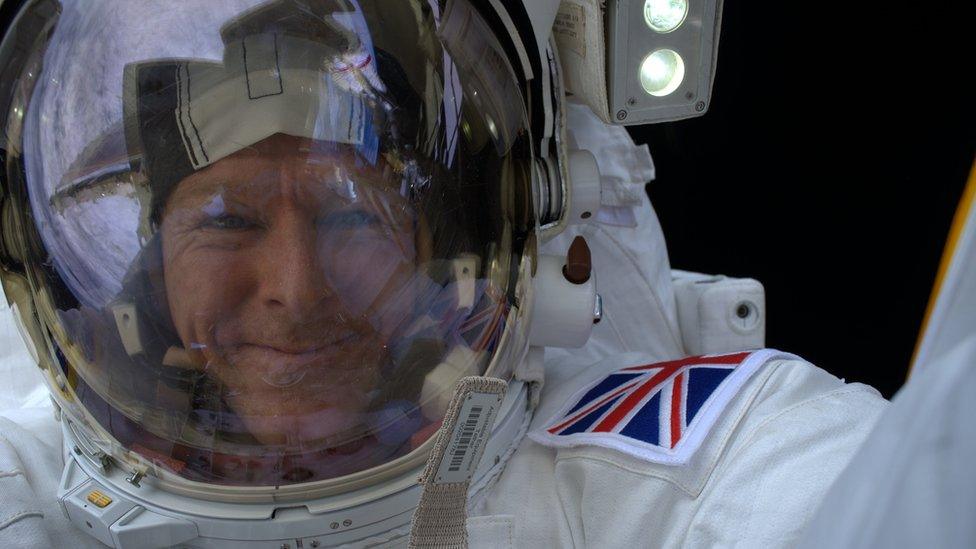Watching Tim Peake return to Earth
- Published

A cheerful Tim Peake was transferred by battered helicopter, after landing in a remote area
Witnessing Tim Peake's descent through the clouds towards the arid emptiness of the Kazakh steppe must rank as one of the highlights of any reporter's career.
At first, we had no idea if we were in the right place but then the parachute appeared as a miniature white blob in the sky as our helicopter circled the landing zone - one of a fleet involved in recovering the spacecraft.
Gradually its white and orange stripes became more distinct, and just visible beneath it was the dark shape of the tiny capsule carrying Tim and his two colleagues.
A column of dust in the distance signalled the rush of the ground vehicles speeding over the bumpy terrain in a desperate hurry to provide help as soon as possible.
By a happy coincidence of winds and flight paths, we had an airborne ringside seat as the near-black craft drifted closer and closer towards the ground.
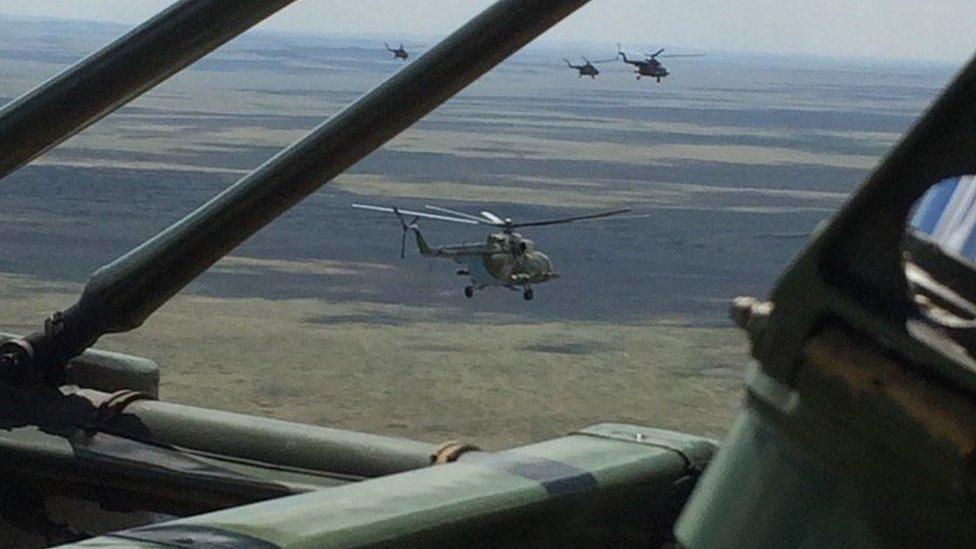
Helicopters raced to the scene of the landing
Although our window was dirty, and the helicopter lurched in the air, we watched spellbound as the Soyuz craft glided delicately towards the pale surface before a flash of explosives broke its fall.
These were the miniature rockets designed to fire a second before impact - everything was working as it should, and it looked uncannily like a Russian space agency animation I'd seen the day before.
A great brown cloud of dry earth surged into the air and, for a few moments, it engulfed the craft so we lost sight of it. But touchdown had been achieved. The giant chute lay draped over the parched grassland.
Dead calm
Within minutes the first helicopters were on the scene, specialists running towards the capsule - the absolute priority was getting the three spacemen to safety.
We landed shortly afterwards, and cameraman Anton Chicherov and I raced towards a small crowd clustered in front of the spacecraft's hatch. A medical tent was already inflated and plastic tape marked out where journalists were allowed to go.
In this blank stretch on the map in the middle of nowhere, more than 100km (62 miles) from the nearest town, the order and procedures of a small community had suddenly sprung up with impressive speed.
Commander Yuri Malenchenko, a veteran cosmonaut, was first to be lifted clear and placed in a small folding chair - tradition demands that returning spacefarers are seated for a few minutes after landing.
Malenchenko's expression was dead calm - he'd seen it all before. This is a man who's so familiar with life off the planet that he even got married in space (while his bride was in Houston).
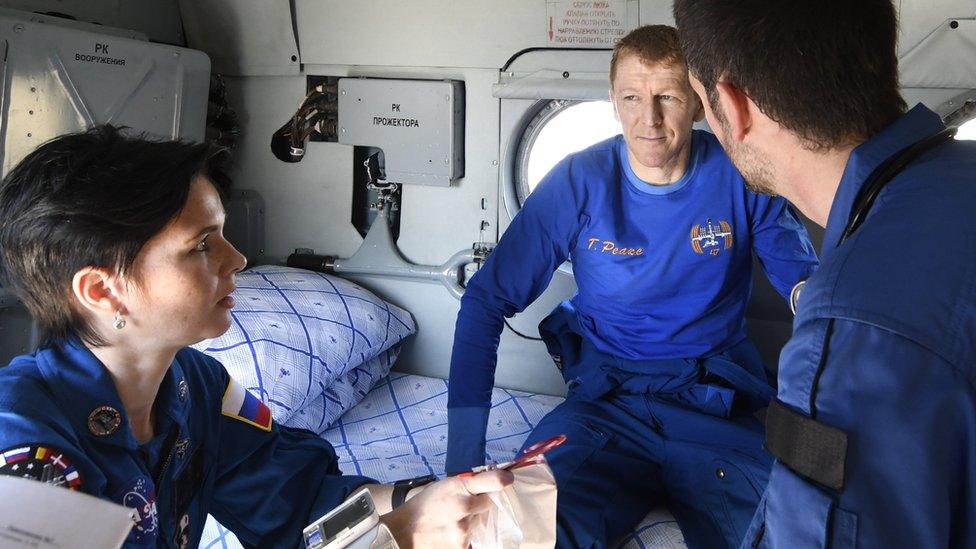
Tim Peake was in the care of recovery staff after landing
Next to emerge was Tim Peake. Pale-faced from six months without sun, he was grinning and relaxed and apparently well.
But the sudden exposure to the baking summer heat obviously left him uncomfortable, medics offering him sips of water and mopping his brow.
Having met him a number of times over the past seven years, I felt moved to welcome him back to Earth. He smiled and said he'd been so well trained that the descent was fine and he was loving the fresh air.
You would never have known he'd just spent a few hours crammed into an agonisingly small spaceship and endured the perils of descent with scorching temperatures and violent swings.
Brutal but reliable
Tim, a model of polite and cheerful efficiency, took every shouted question in his stride. He might easily have declined to respond to the excited curiosity of the British journalists there but, calmly and pleasantly, he maintained his usual courtesy, a very British version of the Right Stuff.
Last out was US astronaut Tim Kopra who looked a little unwell, and he was so thronged by assistants that we could hardly see him, but he was obviously in good hands.
The fact is that the Russians have evolved a brutal but highly reliable system for venturing into space and returning from it. The technology does not look space-age but it works - simple ladders access the capsule, and the spacecraft was rolled upright with a dozen strong pairs of hands.
Once Yuri and the two Tims had been carried to the medical tent for check-up, the officials relaxed enough to let me walk right up to the spacecraft itself.
Even an hour after landing, it was hot to the touch and there was an acrid smell in the air. When I ran my fingers over the charred surface they turned black - evidence of the intense heat of re-entry and the effectiveness of the design for handling it.
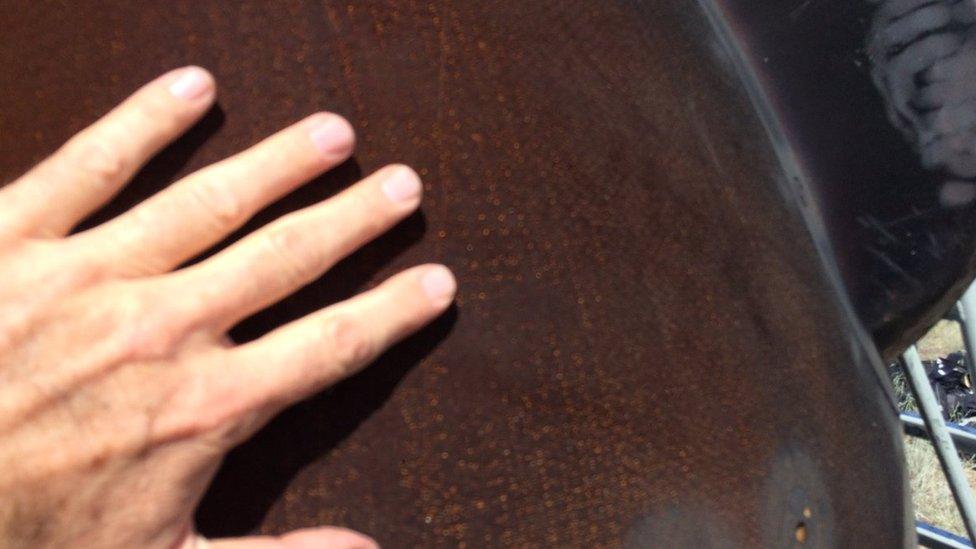
The craft was still hot to touch some time after landing
It's not pretty, let alone glamorous, but the Soyuz is effective and has repeatedly done its job.
First impressions can be deceptive. When I first boarded our very battered Russian Air Force helicopter at Karagandy airport in the morning, I was struck by the utter lack of comfort: two huge yellow fuel tanks dominated the cabin. The stench was overpowering but it meant we had massive range.
I picked one of the few places left - there were no proper seats, just tough canvas benches. I unwrapped a cereal bar. Crumbs spilled everywhere.
And then I learned that this very helicopter was assigned to carry Tim Peake from the landing zone to the airport and that the bench I was sitting on would serve as his bed for the two-hour flight. His first chance to lie down in six months - and I'd messed it up. Sorry, Tim.
- Published18 June 2016
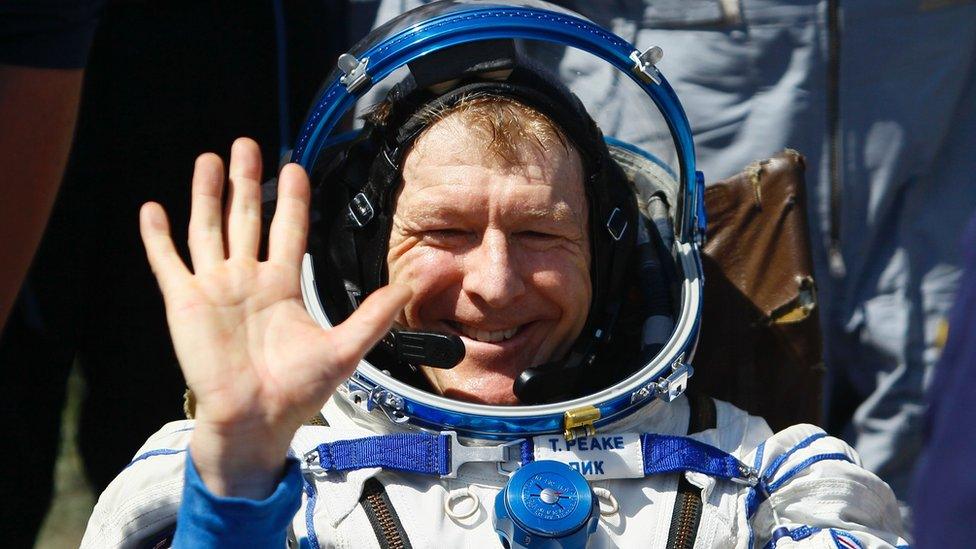
- Published19 June 2016

- Published18 June 2016
- Published18 June 2016
